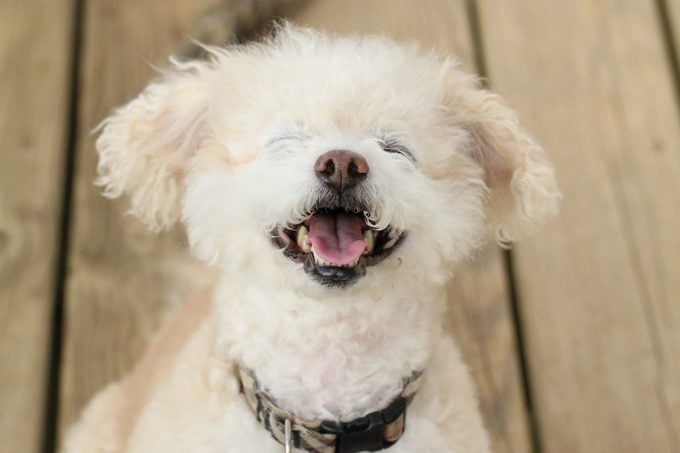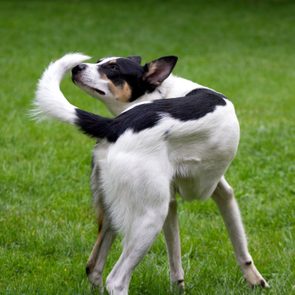Do Dogs Smile? Decoding Your Dog’s Happy Face
Updated: Apr. 04, 2024

Our pups know when we're sad, anxious or happy, and we like to think we know them just as well. But what are those dog smiles really telling us?
Nothing warms our heart quite like our dog’s sweet smile after a long day. We have such close bonds with our pups that it seems natural to associate their facial expressions and even some dog behaviors with those of humans, like when the most affectionate dog breeds snuggle in close to show they care or when your dog stares at you in a plea for extra attention (or a bite of your sandwich). But when it comes to displaying happiness, do dogs smile, or do we just like to think our canine companions share this human trait? We talked to canine behavior experts to find out.
Get Reader’s Digest’s Read Up newsletter for more pet-friendly insights, humor, cleaning, travel, tech and fun facts all week long.
Can dogs smile?
It certainly seems like it! Besides the countless smiles you see from your own happy puppy, there are literally thousands of smiling-dog photos on the internet. Yet, to date, scientists don’t know for sure if our pups are intentionally smiling at us the way our fellow humans do. So even though a dog’s little grins can look astonishingly like our own, research shows that humans and dogs produce distinct facial expressions of emotion and that dogs do not, in fact, use their facial muscles in the same way humans do to express those emotions. However, dogs do seem to make isolated expressions in response to specific emotional stimuli.
For example, when people interpret a smile on a dog’s face, they typically see a couple of different expressions. “One is a soft, relaxed, open-mouth expression that is more likely to be shown when a dog is comfortable, content and otherwise in a low emotional arousal state,” says Christopher Pachel, DVM, a veterinarian and certified animal behavior consultant at the Animal Behavior Clinic in Portland, Oregon.
The other is when the lips are pulled back a bit with an open-mouth expression, often exposing a bit more teeth. This isn’t an aggressive display; rather, it’s an appeasement communication. “You might see this expression when a dog is slightly nervous, panting or otherwise using their body-language communication to defuse a situation they may perceive as somewhat uncomfortable, threatening or stressful,” says Dr. Pachel. Both types of “smiley” expressions can have subtle differences depending on the physical structure of the dog, so it’s important not to overinterpret a particular grin—just like it’s important not to project human sadness when it seems like your dog is crying.
Are dogs actually happy when they smile?
It sure looks like our dogs are happy when they make that adorable grin, especially when it’s accompanied by bright eyes, a wiggly body and a wagging tail. But do dogs smile to convey happiness to humans and other dogs? To date, researchers haven’t found concrete evidence that dogs smile to communicate happiness.
That said, dogs communicate in other ways that tell you what they want and how they feel. “A dog can definitely express emotional states through their body, but it involves much more than the face,” says Angie Madden, a certified dog trainer and the owner of DogSpeak. “Dogs are much more expressive with their entire bodies rather than their faces. We are looking at their ear position, tail position and/or movement—the position, any muscle tension and how their body is moving. This is backed up by behaviors the dogs engage in when exhibiting these physical indicators.”
Remember that open-mouth expression Dr. Pachel mentioned? It signals contentment. And it just so happens that the Oxford English Dictionary defines happy as “feeling or showing pleasure or contentment.”
Now, think about what a positive emotional state looks like in a dog. “If we are looking for signs of relaxation in dogs, we will often see soft musculature. That is the ability to attend to their surroundings without significant alert or startle responses. They are more likely to take food treats gently, and overall their movement patterns tend to be more slow and fluid rather than animated and energetic,” says Dr. Pachel.
Do dogs smile with teeth?
As Dr. Pachel explains, dogs can show off a toothy grin, but it probably has nothing to do with being happy that you just cleaned their teeth. Most of the time, it’s due to appeasement, and it looks a bit different, as the smile isn’t lifting their lips that high. You may have seen this before—like when you came home to find a sofa pillow all torn up and asked your dog, “What did you do?”
While that quizzical doggy head tilt is pretty darn adorable, if they flash you an open-mouth grin with teeth showing, it’s done in indifference, says canine behaviorist Emily Haley, owner of The Dog Listener. “They are trying to appease your negative energy. Dogs will also do this to each other, showing they are not a threat and tucking their ears back and putting their mouth underneath the other dog’s chin,” says Haley.
Now, if a dog exposes their canines, that’s a different story. It’s a defensive move that speaks volumes. “They are trying to say they feel very threatened and insecure,” Haley explains. “And it’s a way to tell other dogs to back off.”
Do dogs laugh?

We can scroll for ages laughing at funny dog photos, but do dogs smile and even laugh in response to humor the way humans do? “It depends on what our definition or reason for laughter is,” says Haley. “If laughter is an expression of joy, absolutely. If laughter is an expression of humor, then no.” Haley has observed joyous laughter in many dogs. It’s a quick inhale and a short exhale when they are in excited, engaged play. Most of the time, dog “laughter” occurs in direct interaction with something. Dogs “laugh it up” with other dogs and humans alike, and it may even happen when they’re playing solo with their toys.
How can you tell if a dog is happy?
Since we can’t sit down with our dogs and discuss how they’re feeling, we have to look to their body language for clues, just as we might seek signs that our dog is secretly mad at us. And the happiness we recognize in ourselves and other humans looks a little different in our canine buddies. Here are the telltale signs.
Bouncy body
“In general, the more loose, bouncy and wiggly their body is, the ‘happier’ the dog’s mental state,” says Madden. A dog with a tight, tense and still body is more likely to be stressed. “Friendly dogs are more likely to have a wiggly body and C-shaped curve to their spine rather than being stiff, rigid or straight through their spine, although this obviously varies a bit based on their breed and physical structure,” Dr. Pachel adds.
Play stance
Play is also a great indicator of a dog’s mental state. You might see your dog do a “play bow.” “With the play bow, they often have their paws spread wide and elbows touching the ground because they pounce into the position,” says Madden. On the flip side, dogs might not solicit or engage in play if they are older, in pain, anxious, fearful or otherwise uncomfortable.
Relaxed resting mode
Outside of playtime, happiness in the form of contentment occurs when a dog is inactive and laying down with their head fully extended on the ground and chin resting on the floor.
A “happy” tail
We can also decode the secrets our dogs’ tails are trying to tell us. For instance, a wagging tail doesn’t always indicate a happy dog. It actually depends on how the tail is wagging. “My favorite ‘happy’ tail is what is sometimes referred to as a helicopter tail. It goes around in circles and every which way,” says Madden. A low, slow-wagging tail is another positive expression.
Eye contact
You might not be able to read your dog’s mind by looking into their puppy-dog eyes, but when they are blinking, that’s a good sign. “When a dog is actively looking at you and blinking, they are in a much more relaxed state,” Haley says.
So there you have it. Just remember: While there are distinct indicators that show how your dog is feeling, don’t look for perfect parallels to human expression. Instead, be happy that your dog is happy!
Sources:
- Scientific Reports: “Dogs and humans respond to emotionally competent stimuli by producing different facial actions”
- Christopher Pachel, DVM, certified animal behavior consultant at the Animal Behavior Clinic
- Angie Madden, certified dog trainer and owner of DogSpeak
- Emily Haley, behavior modification specialist, certified Canine Good Citizen evaluator with the American Kennel Club and owner of The Dog Listener





















